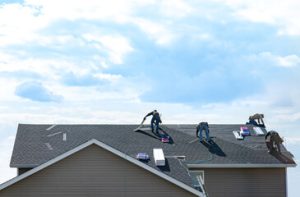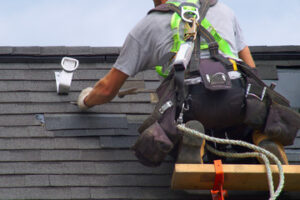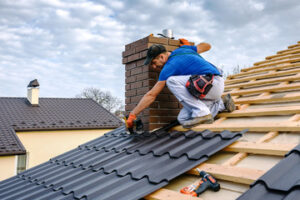Roof Replacement Boston MA is an important investment in the longevity and security of your home. It also adds value and curb appeal, which can make it easier to sell.

Investing in a new roof can also save you money in the long run by reducing your energy bills. However, repairing or replacing your roof can be a tricky decision.
Roofs are essential for protecting the home’s interior and exterior. But they can become damaged over time due to severe weather or age. Whether a repair or replacement is needed, understanding the costs can help homeowners make the best decision for their needs and budget.
The first step in creating a roof replacement estimate is for a professional to perform an inspection and measure the existing roof. This will allow them to determine the scope of work and order the necessary materials. In addition, they will discuss different roofing options and warranties with the homeowner. This is also an opportunity for the homeowner to ask questions and voice any concerns.
Labor costs are a large factor in the overall roof replacement cost. These costs can range from $1 to $11 per square foot, depending on the size of the roof and other factors. In some cases, roofing companies may charge more for labor during certain times of the year or for particularly complex projects.
Another significant factor in the roof replacement cost is the cost of removing the existing roof material. This can be a complicated task, especially if the existing roof is layered or has multiple penetrations. This is often a separate project from the replacement and can add thousands of dollars to the total costs. Homeowners should be aware of this potential additional expense and consider hiring a professional for the removal.
Once the old roof is removed, contractors will apply a waterproof underlayment to protect the new roof. The underlayment can vary in price, with more expensive materials such as slate or metal having higher upfront costs. However, these premium materials can offer longer lifespans and increase resale value, so they may be worth the investment for some homeowners.
After the underlayment is applied, the contractor will install the new shingles or other roofing material. The type of shingles will affect the final cost, with asphalt shingles being the most affordable option. Other more premium shingle materials, such as wood or slate, may have higher prices but can offer greater longevity and enhance the aesthetic of the home.
Materials
If you have a damaged roof, replacing it with the right materials can help ensure that your home is safe and energy-efficient. However, you’ll also need to consider the cost of a new roof. This can vary depending on the property type, roofing material, and other factors.
Asphalt shingles are the most popular roofing material. This is because they’re affordable and durable, with a lifespan of up to 30 years. They come in a range of styles, from basic 3-tab to architectural. You can find them in various color options, including tan and gray.
Other roofing materials that you can choose from include clay tile, slate, and metal. These are usually more expensive than shingle roofs, but they offer better durability and a longer lifespan. However, these materials are heavier than shingle roofs and may require reinforcement of your existing structure to support them.
The type of roofing materials you choose will depend on your preference for appearance and performance. Some homeowners prefer the look of wood shingles, while others enjoy the natural beauty of slate or clay. If you decide to go with a wood shingle or shake roof, make sure that it’s pressure-impregnated to prevent rot and insect infestation. It’s also important to keep in mind that these roof types are more prone to leakage than other roofing materials.
Another option is a synthetic roof, which can be made from polypropylene or polyethylene. They’re molded to resemble the appearance of other roofing materials like slate or cedar, but they have greater longevity and are more resistant to weathering. They’re also easier to install than traditional roofing materials.
When choosing a roof, you should also take into account the size of your home and its location. Larger homes often require more materials, while those in remote locations can increase labor costs. Additionally, a complex roof with chimneys or skylights will also add to the overall price of the project.
Warranty
A roof warranty can offer you peace of mind when it comes to a new roofing project. It can also protect you against unexpected expenses in the future. These warranties usually cover a specific period and certain types of damages. However, it is important to understand that they don’t cover any damages resulting from negligence or abuse. It’s a good idea to discuss the terms of your roofing warranty with your contractor before signing any contract.
Generally, there are two types of warranties: pro-rated and non-pro-rated. A pro-rated warranty operates on a sliding scale, meaning that the coverage decreases over time. This type of warranty is typically cheaper upfront, but it can leave you with a lot of out-of-pocket costs in the long run. On the other hand, a non-pro-rated warranty provides more consistent coverage and can save you money in the long run.
Many reputable roofing contractors provide a warranty on their work. This can give you added confidence in your investment and may even help to attract potential buyers. Some of these warranties are also transferrable to the next homeowner, which can be a big selling point.
While a roof replacement can be costly, it is an excellent way to increase the value of your home and improve its curb appeal. In addition, it can protect your belongings from damage caused by rain and other weather conditions. However, you must take care to choose the right roofing material for your building. There are several factors to consider, including the cost, quality of materials, and warranty coverage.
A reputable roofing contractor will be able to provide you with a detailed warranty that covers the materials and installation. This will give you peace of mind and ensure that you are getting high-quality products and expert installation. Moreover, a warranty will allow you to sell your property with confidence, as it will demonstrate that the roof is in good condition and has been well-maintained. Regardless of whether you are buying or selling your property, you should ask the roofing company to provide a copy of the manufacturer’s warranty before signing any contracts.
Installation
When a home experiences severe roof damage, leaks or other issues that cannot be addressed by simple repairs, it may be time to consider roof replacement. Choosing the right roofing materials and installation method is essential to ensure a long-lasting, secure new roof for your home. There are several factors to consider when deciding between a repair or replacement, including:
The first step in the process is to have a professional examine your current roof and note its condition. This helps the roofing contractor get a better idea of what needs to be done. They will also be able to recommend the best roofing materials for your home based on your budget, style and desired durability. If you are replacing your roof, this is an excellent opportunity to consider additional features like skylights or improved ventilation systems that can help lower energy bills and improve the aesthetics of your home.
After the inspection, the work can begin. Depending on the type of roofing material, this can be a fast or lengthy process. Asphalt shingles are usually quicker and easier to install than other types of roofing materials. Additional details like chimneys, valleys, and skylights can also add to the timeline of your project. The weather can also play a major role in the timeline of your project. Rain, snow, and high winds can all slow down the process.
Once the roof is completely installed, a final QA inspection will be performed to ensure that it was done correctly and to your satisfaction. The roofing company will then clean up your property and remove any old materials. They will also go over your lawn to make sure there are no nails or debris left behind.
While some homeowners may choose to try a DIY roofing job, it is important to leave the task to the professionals. Doing so can be dangerous and may damage your home or void the warranty on the new roof. It is also illegal in many states to perform roof work without a proper license. A reputable roofing contractor will have all of the necessary licensing and insurance to perform quality work on your home.

